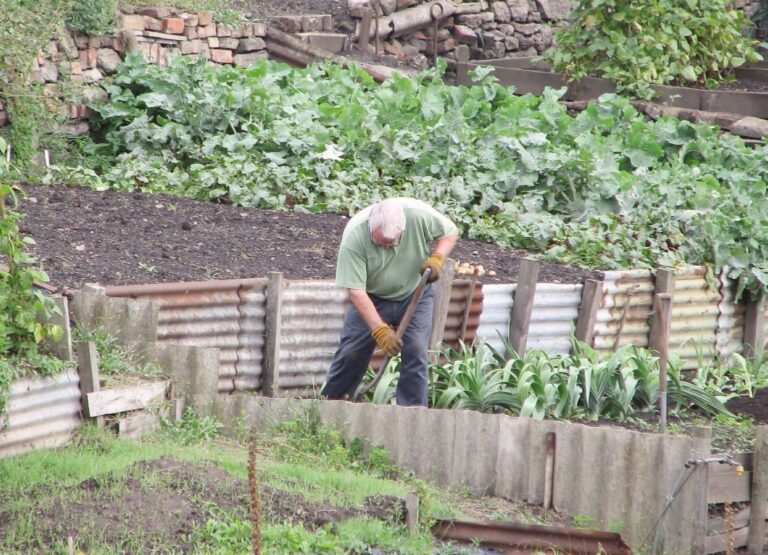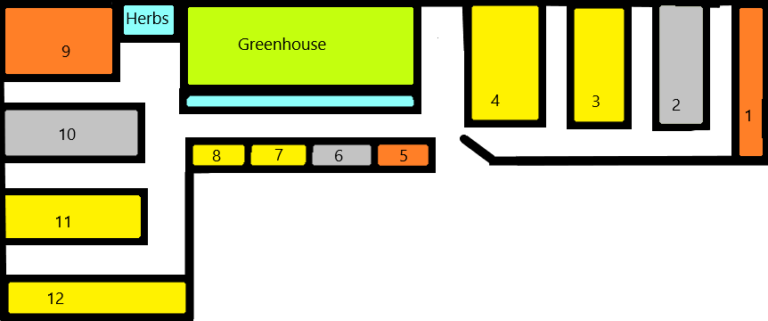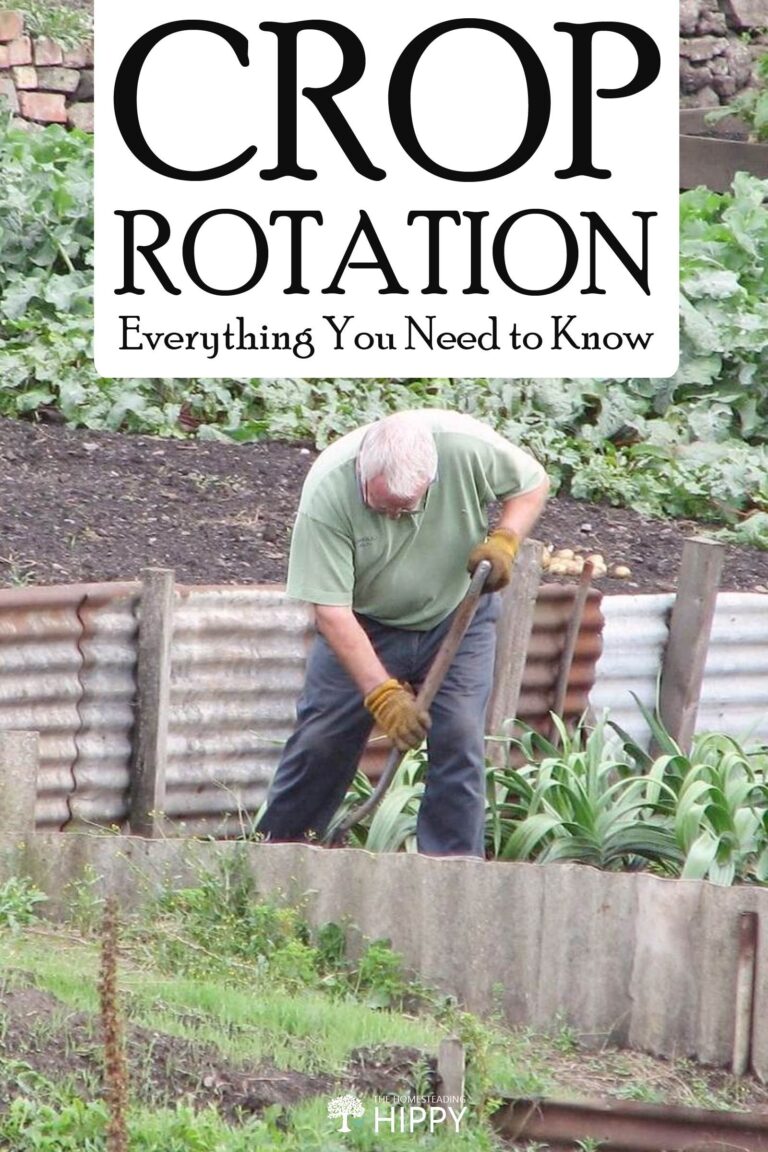Many of us think that crop rotation is something only farmers need to do; however, even on a small scale it is essential to rotate your crops. The very future of your harvests depends on diligent crop rotation.

When you get started, it is really easy to continue. Especially if you are just starting out and still figuring out what to grow where. If you already have your garden and are either already struggling to get good crops going or you are just have not considered what you will grow next year, do not despair, it is not too late to start.
Table of Contents
The Importance of Rotating Your Crops
I think we all beam brightly when we grow our first veggies and harvest a beautiful crop. We are often a little naive thinking; well, that veggie really like that spot, so we delegate that spot as where to plant that crop year after year.
Even though we plant in the right spot with the right light, at the right time of year, we do not get the same yield from that spot. It can really bump your confidence. The one thing we neglected to consider is rotation.
Different vegetables require different nutrients. If you plant the same vegetables in the same place year after year, the soil will be completely sapped of nutrients. This means that eventually your vegetables will not grow in that spot.
Crop rotation also increases the biomass of the different crops root structures which will result in a more diverse environment for growing vegetables.
Crop rotation reduces erosion by improving the structure of the soil. Rotating deep and shallow rooted plants creates a density to the soil that reduces the runoff and slows down the water velocity improving the ability of the soil to retain moisture and nutrients.
A side benefit of crop rotation is that pest and disease cycles are interrupted improving the health of the soil.
What Crop Rotation Is
Crop rotation is exactly what it sounds like. Every year you rotate what you have planted in that space. You are planting several different crops in the same general area in sequential seasons.
Large scale farmers rotate their crops every three years. They typically plant large fields of only one plant every year. They do not have a variety of vegetables each year.
They are farming to sell crops, not to feed themselves every day. However, they are providing nutrients to the soil every year and they give the soil time to rest between plantings.
On a small scale, as homesteaders do, it is even more important to rotate our crops. We have the capacity to grow a variety of plants each year.
This means our soil needs a variety of nutrients each year. We can alternate deep and shallow rooted plants to improve the quality of the soil.
Advantages of Rotating Your Crops
Rotating your crops will:
- Manage your soil better
- Maintain fertility of your soil
- Reduce erosion
- Increase nutrients for☑crops
- Increase the health of soil reducing the cycle of pests and disease
- Retain water better
Rotating your crops has a benefit to the environment. As we move into a more environmentally conscious era, we need to recognize the impact of what we do for future generations.
As homesteaders we tend to be more environmentally conscious because we recognize that the way we utilize our land will have a direct consequence on our future ability to be self-sufficient and live off the grid.
Rotating your crops will:
- ☑ Increase the soil carbon content helping to combat climate change
- ☑ Reduce frequency and tillage intensity
- ☑ Better crop residue management
- ☑ Increase the fertility of the soil
- ☑ Control pests
- ☑ Manage nitrogen content of the soil
- ☑ Shorten the time span needed to rest the soil
- ☑ Combat soil erosion
- ☑ Minimize greenhouse gas emissions
- ☑ Treat water pollution by reducing synthetic fertilizers
- ☑ Increase the ability to store carbon in the soil
- ☑ Improve the soil structure by alternating the root structures improving the organic matter and nutrients
- ☑ Reduce the need to supplement the soil with nutrients
Crop Rotation and Management of Weeds
Let’s face it, there are two major aggravating factors to growing your own veg. 1. Insects and 2. Weeds
Crop rotation can have a great effect on reducing both of these problems. Planting cover crops between bigger crops will choke out the weeds because they will compete well with weeds for space. If your cover crop is working, the weeds will not get the sunlight they need to grow.
Cover crops include:
- Mustard
- Alfalfa
- Clovers
- Rye
- Buckwheat
- Radish
- Cowpeas
There are many others you can use.
Introducing cover crops will improve the health of the soil, smother weeds, and help controlling pests and diseases.
Many people till to get rid of weeds. This is actually not a good idea for two reasons.
- Tilling the soil (overturning the soil) releases the seeds of the weeds back into the soil facilitating the growth of dozens more weeds.
- The seeds of the veggies can be buried under the seeds of the weeds. The weeds will get to the sun first. They will have a head start on the veggies and gain valuable territory.
Weeds can slow down the growth of your veggies, delaying the harvesting process. It is best to get a head start growing your cover crops properly.
Preventing Soil Erosion
Soil erosion takes place when soil is displaced by wind or water. Gradually the soil will lose its nutritional value.
Do not fall into the mindset of ‘yes but it is so gradual that I do not need to fuss about erosion’. Soil erosion will render your property unable to be cultivated to grow anything at all.
Think of sand dunes where nothing grows. It is a wasteland! That is what you are doing to your property and everyone’s earth.
Rotating your crops will reduce the loss of valuable soil by runoff after rain. If you do not till your soil you can greatly influence the soils ability to hold water and provide nutrients. Leave unusable residue from previous crops such as roots, stems, and leaves in the ground (roots) or placed on top of the soil to create a protective barrier from rain that would wash away the soil.
Your earthworms are the most valuable livestock on your homestead. They do not eat live plants. They live off of dead plant material only. What is best is they turn those dead roots, stems, and leaves into compost that is already where you need it. So, protect your worms.
The Tibetan Buddhists have a ceremony: If someone wants to build something; the monks come and take the worms from the ground chanting apologies for the inconvenience of being relocated. The worms are taken to a new area and the ground is blessed for them. I love that!
If I am digging, I am always careful to look out for my worms. Life is life and should always be cherished. It just so happens that worms are the most valuable beings on the planet for their ability to turn dead material into compost that helps conserve our environment.
By leaving roots in place and placing the stubble on the beds you make it harder for rain to wash the loose soil off of the bed. The plant residue in the ground will bind the soil together nicely so that it sticks together forming aggregates that are resistant to the impact of raindrops. Aggregates are also heavier and are therefore harder to displace by wind.
Considerations to Facilitate Crop Rotation
The best way to plan for the future is to actually sit down and PLAN for the future. I mean that literally. I started my career as a journalist for a major newspaper.
My editor freaked out if he saw any journalist without at least 5 pencils and a notepad bigger than themselves to write things down in. I am so grateful to him for establishing this habit for me.
I was involved in an accident that left me with a mind that is not as sharp as it once was. I am so used to my notebook, and it is a fountain of knowledge that I can go back 20+ years to figure out why something is no longer working as well as it did when I started homesteading.
So, what should you do to set up a sustainable vegetable garden?
Know what you want and what is realistic
Do not plant ANY vegetable that your family does not eat. That does not mean that if one member of your family does not like it you should not plant it. I am talking about Brussel sprout, garlic, eggplant YUK!
Make a list of the vegetables your family enjoys and start there – you can also diversify later on a small scale to see if your family is adventurous enough to try something new. Find out what the ideal growing conditions are and if you will have enough space to grow the veggies of your desire.
Spend a bit of time planning your garden. Do not do it once and then set it as an absolute map. Spend at least a week coming back to your plan.
The more you look at it, the more flaws or improvements you will see. But do not stop there. Date your plan (I date by the year) and set up a separate plan for the next year. As you work on your garden according to that year’s plan, you will see what works and what does not.
Quantify how much you want to grow
None of us grow vegetables just to get our hands dirty. We grow to feed our families.
Broccoli, cauliflower, carrots, peas, green beans, and corn all freeze fantastically. Grow as much as you can to freeze for the winter months.
Cucumbers do not freeze well but are great pickled. Lettuce and microgreens do not freeze well at all. Grow only what you will use in a week. As you harvest you should plant a new seed or seedling for your on-going needs.
Plan for short term and for long term and prioritize your goals
What do you want to grow immediately, where you will be planting, and how you plan on growing your veggies?
Keep the big picture in mind. Keep in mind how you are planning to protect the integrity and health of your soil. Unless you are farming with hydroponic systems, soil is the most important aspect of growing.
Understand the root systems of your plant. You need to alternate short roots planted on last years deep root and deep root into last years shallow root plants.
Know Your Roots to Improve Your Harvest Year After Year:
Group together the different root crops to plan your own rotational group
I do this by grouping the veggies based solely on what my family will eat:
Shallow Rooted:
| Broccoli | Peas | Beans |
| Summer squash | Cucumbers | Spinach |
| Chard | Corn | Cabbage |
| Lettuce | Onions | Mint |
| Potatoes | Radishes | Cauliflower |
| Beets | Bell Peppers | Sunflowers |
Medium Rooted:
| Carrots | Peas | Beans |
| Cucumbers |
Deep Rooted:
| Tomatoes | Pumpkins | Watermelons |
| Baby melons | Sweet potatoes | Green melons |
| Butternut | Hubbard | Gem Squash |
Now match up your layout with your root system groups. Once your map is made and beds have been divided up, each year you will simply move all the colors over by 1 bed to rotate your crops.
I use my fence lines for upright gardening too. You will be amazed at how many veggies can be grown upright. Of course, you have the beans and peas, you have cucumbers, and then there is the unconventional squashes of all kinds.
As the blossoms form into squashes, you will need to make hammocks for each squash, but they grow well without taking over the garden.
Do not put the same plant in the exact same spot in successive years. Plant the new plant a meter away from the previous year’s roots.
Now you are ready to plan for this year’s harvest and for the following years.
Be warned, I have been doing this for many years, so please do not go full tilt and go big from the start. Plant on a small-scale basis to figure out what grows where and, most importantly, what your family will eat and how much of those veggies to grow keeping preservation in mind.
If at first you do not succeed, try, try, try again! We all have bad years. South Africa has been hit with extreme weather.
So far, I have replanted my garden six times this year – and not because it is going so well – we have been having flash floods and icy weather in the middle of summer. Each time I planted; a flash flood took everything I was growing! These things happen.
This was my layout for this year (who knows what will come up where when the flood waters die down):

- deep roots are in orange
- medium roots are in gray
- shallow roots are in yellow
- Bed 1: Sweet Potatoes
- Bed 2: Peas + Cucumbers
- Bed 3: Broccoli
- Bed 4: Spinach + Beets
- Bed 5: Tomatoes
- Bed 6: Microgreens + Radishes
- Bed 7: Swiss Chard
- Bed 8: Lettuce + Onion
- Bed 9: Hubbard Squash + Butternut
- Bed 10: Carrots
- Bed 11: Corn
- Bed 12: Cauliflower + Beans on the fence
- Upright plants on the fences: Gem Squash + Green Melons
- Inside the greenhouse: Seedings + Giant Spinach + Bell Peppers + Chili Peppers
Companion Growing
Companion growing is another method of preserving the soil by planting plants with different root systems in the same bed. You can grow all three root systems together or just two root systems at the same time.
The aim is to use space wisely while benefiting each plant by utilizing what attracts and what repels certain insects, what attracts pollinators, preventing soil erosion, and destroying trap cropping (patterns that will reduce the value of the soil over time).
The most common combination is the Native American Three Sisters method. Growing pole beans, corn, and squash can improve the taste, but most importantly, it is mutually beneficial to all three plants.
Methods for Rotating Your Crops
Farmers use a variety of methods to preserve the quality of their soil. These methods can be used in your vegetable garden easily.
Standard Crop Rotation
They plant one crop one year and a different crop the next year. As homesteaders, we all want variety; however, instead of going bonkers growing a plethora of veggies, you could plant fewer types choosing to focus on vegetables that can be frozen or canned. You can pick two veggies from each root system and rotate those crops.
If you have a climate that makes it possible to grow in summer and winter, rotate the beds as discussed above.
Sequential Cropping
When sequential cropping, farmers will plant two different crops one after the other in the same year in the same field.
As a homesteader, this will require a little planning, but it is 100% doable. If you look at my vegetable garden plan above, if I was planting sequentially, I would leave one box empty and when I harvest the first box, I would plant in the empty box. That way I can still control the different root systems.
Intercropping
To intercrop, farmers grow two or more crops in the same field at the same time. If you are planting straight into the ground (not in boxes) this method would be perfect. All it involves is alternating root systems.
Mixed Intercropping
This is a lazy way to grow your veggies. You will pretty much just throw a mixture of seeds onto the ground without actually creating beds for them. This can be a lot of fun and could be educational for your kids. Make a game of it.
When the seedlings start growing, let your kids guess what vegetable will come from that seedling based on what they see. Then put in markers to say who guessed what. Whoever got the most right gets a reward. You will be teaching your kids to identify plants while having fun.
The biggest downside to this method comes in the form of weeding. Because there are no beds, you will possibly stand on seedlings unintentionally while weeding. You will need to identify what is a vegetable and what is a weed.
The other downside is that vegetables will compete for space which means not all will grow to their full potential.
Vegetables like broccoli, cauliflower, pumpkins, all squashes and melons, require a lot of ground. They grow quickly and will grow over other vegetables choking the smaller plants. They will also make harvesting very complicated.
This method is really all about you. Choose what you want to plant and let what lands land. It is fun and it is very helpful to the soil because you have different root systems interspersed.
Row Intercropping
Take your variety of mixed seeds and plant them in rows. You will need to plant your rows reasonably far apart to get the best yield. This makes weeding and harvesting easy.
I suggest planting your melons and squashes separate from your other veggies so that they have room to spread out. Also, give each seed some space to grow without impeding the growth of its neighbor.
Stir Cropping
Farmers alternate strips of land for different vegetables and grains. You can make your beds longer and broader and seed each bed with one type of vegetable. The strips should be 3 to 9 meters wide.
From season to season you will continue with your crop rotation.
Relay Cropping
Farmers and homesteaders often use this method of crop rotation because of the ease of implementation and production.
Plant one crop with wide spaces between rows. Four weeks later, plant a different vegetable between rows. This means you will be harvesting crops at different times. This also means your crops are less likely to compete for space. You just need to plan and rotate as you continue planting.
Frequently Asked Questions
The layout that I provided in the color-coded crop layout based on the root systems is by far the best method of crop rotation. You will have the best layout for planting, caring for, weeding, and harvesting without damaging your soil.
Absolutely! Crop rotation reduces soil erosion, keeps the soil stable, keeps the soil nutritious, enhances water infiltration, and minimizes surface runoff. You will be helping conserve your soil and will help the planet by rotating your crops.
You should rotate your crops every year. Depending on the method you choose to use, you can rotate your crops in a relay.
In addition to the benefit of keeping your soil healthy, the changes in the soil will also assist in eliminating possible diseases striking down your crops, you will get a better yield, and best of all, the change of venue will suppress the harmful insect population in your garden.
Your soil will lose its nutritional value and your plants will not grow because they do not have the nutrition they need.
I really do not recommend you do not rotate; however, in a pinch, mulch your crops well and water on ground level. Plant only strong resilient plants.
Conclusion
The benefits of crop rotation far outweigh any inconveniences you may think of. You will get the full benefit of healthy soil giving you a great yield of healthy vegetables.
Crop rotation breaks up the cycles of weeds, insects, and diseases giving you more time for more fun things. You will lose less soil to erosion and conserve water.
In other words, picture this:
My absolute favorite teacher in high school was my English teacher. She was so much fun. She would tell us to pull the potatoes out of our ears if we got things wrong, or she would banish us to Australia to pick potatoes.
She would tell us to go and repeat the correct answer to Petunia (her beat up old car that she drove) 50 times. And my favorite, she would climb on top of her desk and jump up and down enthusiastically to demonstrate her disdain or absolute joy.
I will never forget this one day, when a couple of the boys kept getting the tenses incorrect, she climbed onto her desk pulling her hair and loudly banishing each boy by name to Australia to pick potatoes.
What she did not see, was that the school headmaster happened to be walking by. He showed us to shush, crossed his arms, and enthusiastically raised an eyebrow at her just waiting for her to notice him. The look on her face was priceless!
With that said, for right now, I am not Di-Anne Seebregts, I am dear Jenny Melville-Smith, I am on my desk enthusiastically screaming please, please, please rotate your crops.
I have made it super easy for you by explaining root systems, layout, and even color-coded it for you. If you rebel against this plea, GO PICK POTATOES IN AUSTRALIA!


Di-Anne Devenish Seebregts was raised in an environment where daily life consisted of hiking, environmental conservation, growing fruit and vegetables, and raising poultry for meat and eggs.
She combined her passion for the writing word with her love of the pride that comes with not relying on others. She raised three children (who are now adults) to value the environment, and understand the value of being self-sufficient.
Find out more about Di-Anne on our About Us page.

I love this 🌱
Love your site. it is great. A lot of people have forgotten about rotational cropping.